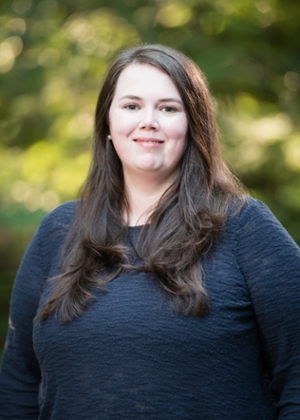Kelly Best Lazar
 Associate Professor
Associate Professor
Department of Engineering and Science Education
Department of Environmental Engineering and Earth Sciences
341 Brackett Hall
M08 Holtzendorff Hall
864.656.9812
E-mail: klazar@clemson.edu
Postdoctoral Fellow, Clemson University, 2016-2018
Ph.D., The Ohio State University, 2014, Geological Sciences
M.S., East Carolina University, 2010, Geological Sciences
B.S., North Carolina State University, 2007, Geology
Classes | Publications | CV
Faculty Overview
Dr. Lazar’s research interests are spread across sedimentology, coastal geology, and geoscience education. Her broad geoscience research investigates Quaternary environmental change, primarily using sedimentological, micropaleontological, and chronostratigraphic techniques. Current projects utilize the sediment record to reconstruct paleo-hurricane histories and concentration and deposition of microplastics in aquatic environments. Her education research focuses on broadening participation in geoscience, and she leverages her fieldwork to provide students with opportunities to learn geoscience in the field.
Class Information
For current syllabi, please search the Clemson University Syllabus Repository.
Selected Publications
Bolick, M.A., Thomassen, M., Apland, J., Spencer, O., Nicole, F., Tran, S.K.N., Voigt, M. and Lazar, K.B. 2024. Project-Based Learning in Interdisciplinary Spaces: A Case Study in Norway and the United States. Education Sciences 14(8), 866.
Boyd, E.A. and Lazar, K.B. 2024. “I’m still here and I want them to know that”: experiences of chemists with concealable identities in undergraduate research. Chemistry Education Research and Practice.
Boyd, E.A., Lazar, K.B. and Voigt, M. 2024. Humanizing geoscience education research through participant-driven visual representation. Journal of Geoscience Education 72(1), 15-23.
Boyd, E.A., Lazar, K.B. and Moysey, S. 2023. Big data to support geoscience recruitment: Novel adoption of topological data analysis in geoscience education. GSA Bulletin 136(3-4), 1458-1468.
Bowman, C., Lazar, K.B., Carraway, E., Ladner, D.A. and Whitmire, S.L. 2024. Fluvial Concentrations of Microplastics in a Suburban Micro-Watershed: Sampling Methodology and Analysis. Environmental Engineering Science. Boyd, E.A. and Lazar, K.B. 2024b. Undergraduate Research Science Capital: Measuring capacity to engage in research. PLOS ONE 19(10), e0310053.
Boyd, E. and Lazar, K. 2024a. Development of the Undergraduate Research Science Capital Scale. Scholarship and Practice of Undergraduate Research 7, 44-54.
Walker, E.B. and Lazar, K.B. 2022. Students as Science Content Creators and Evaluators: A Case Study of Video Documentary Storytelling in Science Education. Journal of College Science Teaching 52(2), 3-5.
Boyd, E.A. and Lazar, K.B. 2022. “It’s not just a picture”: The effects of an international two-week field experience on student geoscience involvement and persistence. Journal of Geoscience Education 70(3), 399-411.
Lazar, K.B. and Moysey, S.M., 2020. Enabling student self-guided field expeditions in geoscience with the GeoXploration Platform for mobile apps. Applied Computing and Geosciences, https://doi.org/10.1016/j.acags.2020.100028.
Moysey, S.M. and Lazar, K.B., 2019. Guidelines for using Virtual Reality as a Tool for Field-Based Learning in the Earth Sciences, In: S. Macdonald and R. Lansiquot, Interdisciplinary Perspectives on Virtual Place-Based Learning, Palgrave Macmillan.
Dipre, G., Polyak, L., Kuznetsov, A., Oti, E., Ortiz, J., Brachfeld, S., Xuan, C., Lazar, K., and Cook, A. Plio-Pleisocene sedimentary record from the Northwind Ridge: first insight into paleoclimatic evolution of the western Arctic Ocean for the last >5 Ma., 2018. Arktos.
Lazar, K.B., Moysey, S.M., Brame, S., Coulson, A., Lee, C., and Wagner, J., 2018. Breaking out of the traditional lecture hall: Geocaching as a tool for experiential learning in large geology service courses. Journal of Geoscience Education DOI:10.1080/10899995.2018.1453191.
Rashid, H., Piper, D.J.W., Lazar, K.B., McDonald, K., and Saint-Ange, F., 2017. The Holocene Labrador Current: changing linkages to atmospheric and oceanographic forcing factors. Paleoceanography DOI: 10.1002/2016PA003051.
Lazar, K.B. and Polyak, L., 2016. Pleistocene benthic foraminifers in the Arctic Ocean: implications for sea-ice and circulation history. Marine Micropaleontology 126: 19–30.
Lazar, K.B., Polyak, L., and Dipre, G., 2016. Reexamination of the creation of Cassidulina neoteretis (Foraminifera) and its use as a Pleistocene biostratigraphic marker in the western Arctic Ocean. Journal of Foraminiferal Research 46: 115–123.
Lazar, K.B., Mallinson, D.J., and Culver, S.J., 2016. Foraminifera and Late Quaternary evolution of the Croatan Beach Ridge Complex, Bogue Sound, and Bogue Banks, NC. Estuarine, Coastal and Shelf Science 174: 49–64.
Polyak, L., Best, K.M., Crawford, K.A., Council, E.A., and St-Onge, G., 2013. Quaternary history of sea ice in the western Arctic Ocean based on foraminifera. Quaternary Science Reviews 79: 145–156.
Rashid, H., Otieno, F.O., Best, K.M., and C. K. Shum, 2013. Analysis of Paleoclimate Records for Understanding the Tropical Hydrologic Cycle in Abrupt Climate Change. Climate Vulnerability: Understanding and Addressing Threats to Essential Resources. Elsevier Inc., Academic Press, 127–139 pp. [ISBN: 9780123847034]

